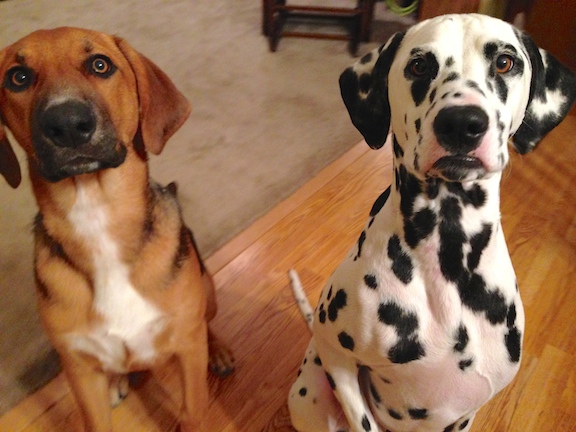Helping a Dalmatian and Mix Owner Learn that Rules and Boundaries are Great for Behavior
By: David Codr
Published Date: September 2, 2014
 Meet Sadie a six-month-old female mix and Bentley a one-year-old Dalmatian.
Meet Sadie a six-month-old female mix and Bentley a one-year-old Dalmatian.
At this point I’ve rehabilitated over 700 dogs, but today was the first time I had a client with a Dalmatian. So much for the rumors that all Dal’s are trouble-makers. As a long time Dal owner, I have to say I was looking forward to this session slightly more than usual.
Bentley’s owner had contacted me concerned about some behaviors he had started to show; barking aggressively while looking out the window at anyone passing by the house and growling or barking at strangers.
When I arrived for the session Bentley was prevented from getting to the front door by a baby gate. I avoided eye contact with him and took a more relaxed body position which seem to have a good effect on him. He didn’t bark and only growled a little at the beginning. Once Sadie and Bentley had given me a good sniff and started to relax themselves I came in and sat down with their owner.
Usually I start things off by asking an owner what sort of rules, boundaries and structure they have incorporated into their dog’s lives to get a feel for how I can best help them. But in Bentley’s case it was pretty easy to see. Bentley’s owner had wanted a Dalmatian for so long that she almost over-loved the dog. Just about every time Bentley came near her, she reached out to pet him. I say “just about” because every time his owner failed to reach out to pet him when he walked by, he stopped, turned around and either crawled up or jumped up on top of his owner. Within the first five minutes of my conversation with his owner, Bentley jumped up on her nine times.
When I explained that petting Bentley every time he jumps up on her is actually reinforcing that behavior, his owner was a bit flabbergasted. His owner had interpreted Bentley jumping up on her as his attempts to show her affection. His owner is a wonderfully caring woman who loves her dogs deeply, but she believed that correcting or disagreeing with unwanted behaviors was akin to being “mean” to them.
In reality, dogs respect and respond better to clear leadership and a great way to show that is by incorporating clear rules, limits and boundaries.
To help change the current leader follower dynamic, I suggested that his owner adopt a stand-up strategy every time a dog jumped up onto her lap. Standing up does two things: first it gets the dog off of the human, and secondly it puts the human in the more authoritative position.
Bentley’s owner had to stand up four or five times before he figured it out and stopped jumping up on her. It will be important that Bentley’s owner continue to disagree with his attempts to climb on top of her or demand affection from her this way. If she does this consistently, he will adopt a new method to ask for affection. To take advantage of this, I suggested she adopt the “nothing in life is free” philosophy. By only petting Bentley when he follows a command from her, it should be easy for her to assume a more authoritative position in his eyes.
I suggested that she adopt some rules and boundaries to help further reinforce Bentley’s follower position. Not being allowed int he kitchen when food is being made or around the table when people are eating are small steps, but to dogs, they can have a big impact.
Because dalmatians are such an intelligent breed I demonstrated a mental exercise that challenges Bentley to restrain himself. It only took three repetitions before he understood the rules of the exercise at which point I had his owner take over. It was just as easy for her to get Bentley to ignore the high-value treat.
By practicing this exercise with both dogs separately every day for the next 2 to 3 weeks, both dogs will learn to see their owner as the authority figure in the home. It will also help their owner see that asking the dogs to follow commands or stop unwanted behaviors is a good thing.
Once both dogs learn to respect the authority and respond to the commands of their owners, they will be able to disagree with any behavior that either dog engages in, including barking at strangers.
Categorized in: Dog Behavior, Dog Psychology, Dog trainer in omaha, Dog trainer Nebraska, Dog Training Omaha, Nebraska dog training, Omaha dog training



